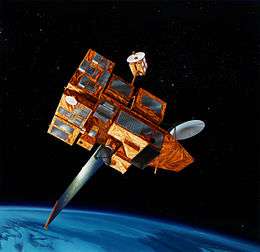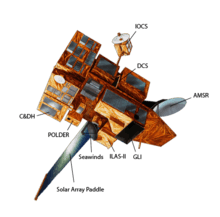ADEOS II
ADEOS II (Advanced Earth Observing Satellite 2) was an Earth observation satellite[2] launched by NASDA, with contributions from NASA and CNES, in December 2002.[3] Its Japanese name was Midori 2,[4] and it was the successor to the 1996 mission ADEOS I. The mission ended in October 2003 after the satellite's solar panels failed.[5]
 Illustration of ADEOS II | |||||||||||||
| Names | Advanced Earth Observing Satellite II Midori II | ||||||||||||
|---|---|---|---|---|---|---|---|---|---|---|---|---|---|
| Mission type | Earth observation Environmental monitoring | ||||||||||||
| Operator | NASDA / NASA / CNES | ||||||||||||
| COSPAR ID | 2002-056A | ||||||||||||
| SATCAT no. | 27597 | ||||||||||||
| Mission duration | Final: 10 months, 9 days | ||||||||||||
| Spacecraft properties | |||||||||||||
| Manufacturer | Mitsubishi Electric | ||||||||||||
| Launch mass | 3,680 kg (8,110 lb) | ||||||||||||
| Dimensions | 4 × 4 × 5 m (13 × 13 × 16 ft) | ||||||||||||
| Power | 5 kW | ||||||||||||
| Start of mission | |||||||||||||
| Launch date | 14 December 2002, 01:31 UTC | ||||||||||||
| Rocket | H-IIA 202 | ||||||||||||
| Launch site | Tanegashima Yoshinobu 1 | ||||||||||||
| End of mission | |||||||||||||
| Disposal | Spacecraft failure | ||||||||||||
| Last contact | 23 October 2003, 23:55 UTC | ||||||||||||
| Orbital parameters | |||||||||||||
| Reference system | Geocentric | ||||||||||||
| Regime | Sun-synchronous | ||||||||||||
| Eccentricity | 0.0002068 | ||||||||||||
| Perigee altitude | 799 km (496 mi) | ||||||||||||
| Apogee altitude | 802 km (498 mi) | ||||||||||||
| Inclination | 98.3466° | ||||||||||||
| Mean motion | 14.27 rev/day | ||||||||||||
| Epoch | 27 December 2016 23:58:05 UTC[1] | ||||||||||||
| |||||||||||||
Mission overview
The three primary objectives of the mission, as identified by NASDA, were to:[6]
- Regularly monitor the water and energy cycle as a part of the global climate system
- Quantitatively estimate the biomass and fundamental productivity as a part of the carbon cycle
- Detect trends in long term climate change as a result of continuing the observations started by ADEOS
The project had a proposed minimum life of three years,[7] with a five-year goal.[8]
Launch
The mission was originally scheduled to launch aboard a H-II rocket in February 2002. This was postponed as the Japanese Space Activities Commission would not launch without having three successful missions aboard the new H-IIA rocket.[9]
The satellite was successfully launched from Tanegashima Space Center pad YLP-1 on 14 December 2002, aboard H-2A-202.[10] Other payloads onboard included the Japanese MicroLabsat and WEOS devices, as well as the Australian FedSat.[4]
Failure
On 23 October 2003, the solar panel failed.[5] At 2349 UTC, the satellite switched to "light load" operation due to an unknown error. This was intended to power down all observation equipment to conserve energy. At 2355 UTC, communications between the satellite and the ground stations ended, with no further telemetry received.[5] Further attempts to procure telemetry data on 24 October (at 0025 and 0205 UTC) also failed.[11]
Investigation
After the power failure, JAXA (NASDA's successor) formed the Midori II anomaly investigation team. Analysis of data received before transmissions ceased showed that the solar panel's power output had decreased from 6 kW to 1 kW.[5] The investigation team began surveying the mission to establish whether the failure was due to a technical malfunction or a solar flare.[5]
One hypothesis was that debris had impacted the satellite's power harness between the solar array and the satellite bus. The harness was a core of wires enclosed in multi-layer insulation. The debris impact was theorised to have caused an electric arc.[2]
The mission officially ended at the end of October 2003, with JAXA conceding that the "possibility of restoring the operations of Midori II [was] extremely slim."[5] The mission, which had cost approximately 70 billion Yen (US$570 million)[4] was only able to recoup an estimated 300 million Yen through insurance.[5]
Instruments

The satellite was equipped with five primary instruments – Advanced Microwave Scanning Radiometer (AMSR), Global Imager (GLI), Improved Limb Atmospheric Spectrometer-II (ILAS-II), Polarization and Directionality of the Earth's Reflectances (POLDER), and SeaWinds. These instruments were designed to monitor Earth's water cycle, study biomass in the carbon cycle, and detect trends in long-term climate change.[7] The mission was established to continue the work undertaken by ADEOS I between 1996 and 1997.[7][12]
Subsystems
In addition to the five main instruments, nine avionic subsystems were allocated to the bus module.[2] These were the Communication and Data-Handling Subsystem (C&DH), Inter-Orbit Communication Subsystem (IOCS), Mission Data Processing Subsystem (MDPS), Optical Data Recorder (ODR), Electrical Power Subsystem (EPS), Paddle Subsystem (PDL), Attitude and Orbit Control Subsystem (AOCS), Reaction Control Subsystem (RCS), and the Direct Transmission Subsystem (DTL).[2]
The C&DH subsystem received and decoded the satellite's tracking control command signals and acted as a processing interface between the instruments. It was capable of adjusting settings on the instruments – such as temperature and voltage. The IOCS was used to communicate with data relay satellites (see Data transfer).[2]
The MDP device formatted mission data to be sent via the IOCS, and would process it into a data packet.[2] The ODR was a large-volume storage device that used an optical magnetic disk system.[2] The EPS provided power to the satellite's subsystems. The PDL managed the satellite's solar panel, and transferred electrical energy to the EPS. The solar panel was capable of generating 5 kW using 55,680 cells on a jointed mast.[2]
The AOCS was used to establish the attitude control following the satellite's deployment from the rocket. It was subsequently used to adjust the satellite's attitude, orbit, and solar paddle. The AOCS was equipped with a number of attitude sensors, including a control-standard unit (IRC), an Earth sensor (ESA), and a fine sun sensor assembly (FSSA).[2]
The RCS was used to generate propulsion power for attitude adjustments after deployment and control orbit using data from the AOCS.[2]
Data transfer
ADEOS II transferred data to and from Artemis and the Data Relay Test Satellite (DRTS). The Artemis connection transferred information over a 26 GHz Ka band link (for payload data) and a 2 GHz S band link (for telemetry, tracking and control data).[2]
These signals were then downlinked to the Earth Observation Center (EOC) via feeder link stations and the Redu Station.[2] ADEOS II also sent mission data directly to NASA stations, which routed information to bodies such as the EOC and sensor-providing organisations.[2]
Footnotes
- "ADEOS II - Orbit". Heavens Above. 27 December 2016. Retrieved 28 December 2016.
- Earth Observation Portal (2008)
- International Laser Ranging Service (2010)
- Andrews Space & Technology (2001)
- Satellite News Digest (2003)
- Japan Aerospace Exploration Agency (1999)
- NASA Earth Observing System (2007)
- Kramer (2002, p. 335)
- Jet Propulsion Laboratory (2002)
- Krebs (2010)
- Japan Aerospace Exploration Agency (2003)
- Satellite News Digest (2006)
Sources
- Andrews Space & Technology (2001), Midori 2 (ADEOS 2) - Summary, Tukwila, WA: Space and Tech, archived from the original on 22 June 2011, retrieved 17 September 2010
- Earth Observation Portal (2008), ADEOS-II (Advanced Earth Observing Satellite-II) / Midori-II, Frascati, Italy: ESA Centre for Earth Observation, archived from the original on 21 July 2011, retrieved 18 September 2010
- International Laser Ranging Service (2010), ADEOS-2, Washington, DC: NASA, archived from the original on 27 September 2010, retrieved 17 September 2010
- Jet Propulsion Laboratory (2002), Missions - SeaWinds on ADEOS II, Washington, DC: NASA, archived from the original on 20 September 2010, retrieved 18 September 2010
- Kramer, Herbert J (2002), Observation of the Earth and Its Environment: Survey of Missions and Sensors, Berlin, Germany: Springer Science+Business Media, ISBN 3-540-42388-5
- Krebs, Gunter (2010), ADEOS 2 (Midori 2), Germany: Gunter's Space Page, retrieved 19 September 2010
- NASA Earth Observing System (2007), Advanced Earth Observing Satellite II (PDF), Washington, DC: NASA, archived from the original (PDF) on 9 June 2010, retrieved 17 September 2010
- Satellite News Digest (2006), Midori I (ADEOS I), Luebeck, Germany: Sat-ND, retrieved 18 September 2010
- Satellite News Digest (2003), Midori II (ADEOS II), Luebeck, Germany: Sat-ND, retrieved 17 September 2010
- Japan Aerospace Exploration Agency (15 November 1999), Scientific Goal, Chōfu, Tokyo: JAXA, retrieved 27 September 2010
- Japan Aerospace Exploration Agency (25 October 2003), Operational Anomaly with Midori-II, Chōfu, Tokyo: JAXA, retrieved 27 September 2010
- Japan Aerospace Exploration Agency (2007), Advanced Earth Observing Satellite-II "Midori II"(ADEOS-II), Chōfu, Tokyo: JAXA, retrieved 18 September 2010